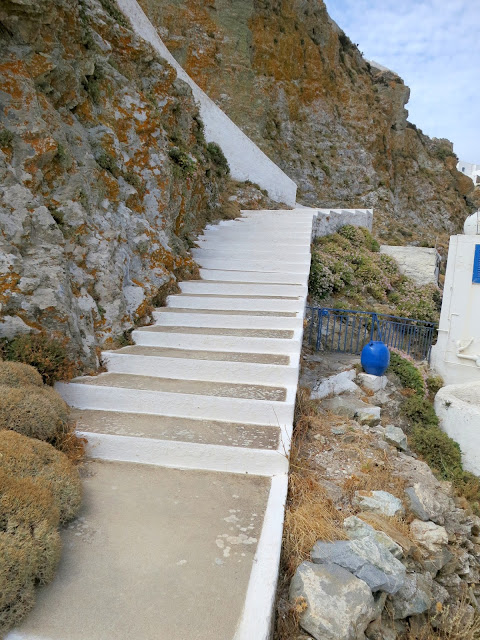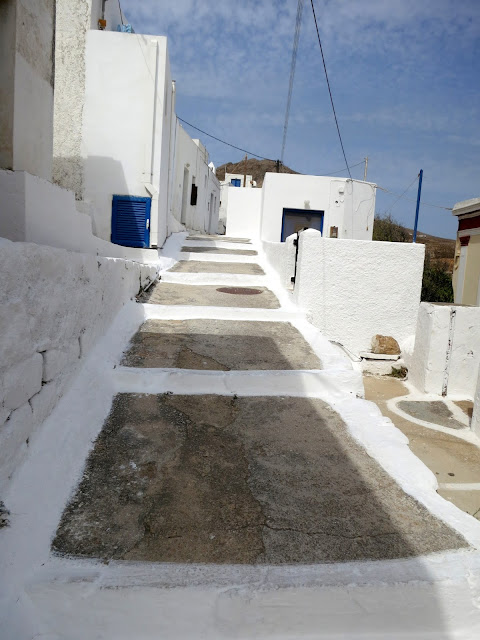'Everything architecture had to say, was told here',
said Corbusier when he visited the Cyclades in 1933.
A typical medieval, fortified settlement, built amphitheatrically on the rocky hill, the Hora in Serifos is dominated by the remnants of the ruined Venetian castle that was built in 1434. From there, the village cascades down the slope.
During the years of Venetian rule people lived in fear of pirate invasions and were consequently forced to leave the coast. The houses in Hora have been built in such a way as to create a wall all around the village in order to provide protection against invasion.
It's a typical Cycladic village - extreme minimalism
the houses, consecutive white cubes
whitewashed labyrinthine narrow streets
paved, with white joints
steps
and more steps
 |
limited space means narrow frontages with narrow doors
fabulous chimneys

In tight corners, the sides of buildings 'break' to allow the loaded mules to pass through
Nowadays the image of the white houses is the hallmark of the Cyclades. Historically though, these houses were painted in various colours: ochre, gray, indigo. They often also remained unpainted in the colour of the stone: when the Aegean was swarmed with pirates, visual integration in the landscape was the only reasonable choice.
In 1938 cholera spread through the region and it affected domestic birds. The government ordered the whitewashing of all houses on the islands, as lime is a strong disinfectant. Police patrolled the villages to make sure that everyone obeyed. The houses have remained white ever since.
We visited the Hora on our first day on the island. We walked around the narrow streets
heading for the ruined castle. The views were spectacular
the ochre/brown of the hills contrasted with the blue of the sea and the sky.
Looking back at the Western side of Hora
An old windmill in the foreground and the sea in the distance
View of Livadi
We eventually got to the area of the ruined castle with the church of Agios Constantinos above us.
We stopped to admire the view
and then reached the church of Agios Giannis Theologos. According to tradition, this is where the ruins of the ancient temple of Athena were.
A rest here

to admire more views - Livadi, again
then continued on the path until we got to a dead end.

The prickly pear presiding over the landscape
We then retraced our steps
walked through the village
some of the streets are so narrow
detail
Most of the bars and shops are closed during the day and open in the evening
and went to look at the three restored windmills
which are dwellings now
and then it was time to take the bus that would take us down to Livadi.




































A dream for the eyes, but it looks like a nightmare for my knees!
ReplyDeleteI was shattered by the end of it Olga, and it took me a long time to recover. I didn't climb up to the highest bit where one of the churches is: Ken did and I just rested and waited. But, I'm glad I was able to do most of it. Unfortunately, most of these villages of the Greek islands are like this - there are lots of bits of Hydra that I have not explored.
DeleteInformative post & Amazing Images! Serifos is certainly one of the fascinating Greece Islands. This Island draws thousands of travelers every year because of the ruined Venetian castle, white-washed houses, labyrinthine narrow streets & magnificent view of the sea. A Greece Tourist Visa is all that it takes to get to this charming Greek Island.
ReplyDelete